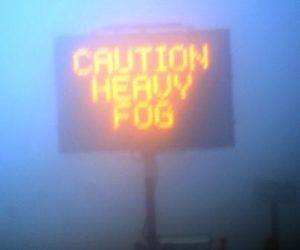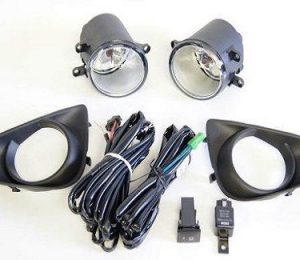
Although fog can happen at any time of the year we often see this phenomenon during the spring and fall driving seasons. Without getting too scientific, the reason for this, points back to how Mother Nature generates fog.
Of course, fog is the result of cold air passing over a body of warm water or land with some moisture content. Here in the United States we get a lot of cold fronts during the spring and fall season.
Drivers have a lot of things to consider when using fog lights and those without them might consider adding them to their automobile for emergency situations. Therefore, we’ll talk about how fog lights work and compare factory installed fog lights with aftermarket solutions.
Does Using Fog Lights Really Work
Some say that fog lights are added to a new automobile to provide the sales force with an extra benefit to use in the sales process. They also look pretty cool even when they’re off. With that said, fog lights can actually help you see better depending on the thickness of the fog you’re driving through.

The problem with using the vehicles high and low beam headlights in foggy conditions is twofold. The reason headlights remain ineffective at seeing through fog is thanks to the moisture particles contained in the mist. These water droplets reflect the light back at the driver. This is why when you turn on the high beams, you see less than the low setting. When you add more light it just shines back at you more intensely.
The other problem with using headlights to see through dense fog is the height at which these lights shine. The theory behind fog lights is you mount them low to see underneath the fog. When fog forms it’s less dense at ground level. Not only do the fog lights attempt to shoot beams of light underneath the heaviest concentrations of fog, but they also light the roadway effectively. This is why fog lights often mount below the front bumper in factory installed situations.
Using Fog lights Installed as Original Equipment

On domestic automobiles you’ll find the fog light controls mounted on the combination lever that also operates the headlights and high beams. On many German cars from Mercedes-Benz or BMW automobiles you’ll often find a separate switch that operates the fog lamps.
Car makers adopted the standard symbol of what appears as a headlight with a few squiggly lines running through it as the universal symbol for the fog lamp system. Car manufacturers also standardized a few of the key operational features included in this safety feature.
This becomes important, because many drivers misunderstand how they operate and might think they’re broken. The fog lights in a factory installed system won’t turn on until you activate the headlights. In other words, they don’t work independently as they might with an aftermarket installation with a separate switch.

In addition to having the headlights on you also must have the high beams in the off position for the fog lights to stay on. They incorporate this rule, because turning on the high beams makes it harder to see through dense fog as described above.
On many domestic and Asian automobiles a notification illuminates on the instrument cluster when we activate the fog lamps. The nice part about factory installed systems becomes the ongoing support offered.
Whether you need a replacement fog lamp bulb or need help diagnosing a defective relay on your Ford F150 pickup truck you get easy access to parts and information.
Using Aftermarket Fog Lights

Sometimes mechanics will refer to off-the-shelf fog lights as an aftermarket auxiliary lighting kit. When you go to purchase these types of systems buying a complete kit is recommended over buying the parts separately. Let me explain this a little further. You can go out and buy a set of high-powered fog lamps and a switch. And set up a homemade system that turns on and off using that toggle switch.
However, the way to go is to install a bundled kit. Buying a fog lamp kit can provide better reliability and compliance with local laws. These complete kits come with a relay, the fog lamps themselves and a switch assembly. It’s nice to have a relay in this circuit, because of the powerful lamps in a fog light kit. These high intensity lamps draw a lot of current. Using the relay takes the load off of the switch and the wiring that runs inside the car. The obvious advantage of using a relay set up remains the reduction of overheating.
Problems with Installing Aftermarket Fog Lamps
If you own a newer car read this article about how aftermarket parts void the warranty. When you’re installing an aftermarket kit you don’t want to confuse off road lighting with fog lighting. We’ve all seen those lifted four-wheel-drive pickup trucks with lights mounted on the roll bar. We call this off-road lighting. It doesn’t help in foggy situations.
When you’re looking to see through the fog the lower the lamp is mounted yields the best results. The goal becomes to slide a wide beam of focus light underneath the fog layer. The downside to mounting these lamps low on the automobile is the possibility of damage. They’ll be susceptible to road debris, deep water, ice and snow. If you live in an area of the country where these types of hazards exist, you might want to spend a little more on the fog lights themselves. Select lamps that include waterproof housings and stone guards that cover heavy duty glass to protect your investment.
Another thing to consider that many people forget is the electrical load the additional lighting puts on the automotive electrical system. In a factory installed fog lamp situation they design the car from the ground up to carry this additional load. When you add an aftermarket system you’ll also add an additional 25 Amp draw to run those lights. When you add this to charging cell phones and additional accessories plugged into power outlets you can push power requirements past the vehicles capabilities. If your alternator outputs maximum power at all times it will shorten the life of this charging system component.
